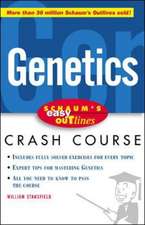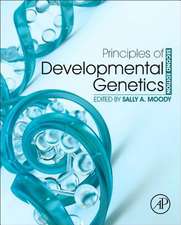Nuclear Reprogramming and Stem Cells: Stem Cell Biology and Regenerative Medicine
Editat de Justin Ainscough, Shinya Yamanaka, Takashi Tadaen Limba Engleză Paperback – 21 oct 2014
Since the early 1950s a small number of notable experiments have provided significant impetus to the field, primarily the demonstration of reprogramming ability, first by the complex cytoplasmic milieu that constitutes the amphibian egg, then that of the mammalian egg, and finally that of the mammalian embryonic stem cell. Most recently, the demonstration that a limited pool of defined molecules is capable of reprogramming a multitude of cell types has provided massive impetus and facilitated transition towards realistic therapeutic application. We have therefore reproduced some of the key articles that elegantly document these dramatic stages of development of the field in an inclusive appendix to the book, for the benefit of readers keen to investigate the history of how the field of stem cell biology has evolved.
Owing to the ever broadening nature of this field, and the incredible rate at which it is evolving, the main content of this volume focuses on areas that have shown significant movement in recent years, are most likely to translate into personalized therapeutic application, and thus provide greatest potential for significant impact on human health inthe not too distant future. We recognize that research into many other disease states and cell types are all equally worthy of discussion. We would therefore like to acknowledge those researchers involved whose work we have not been able to include in this volume. Nuclear Reprogramming and Stem Cells will serve as a valuable resource for all researchers in the field of stem cell biology, including those just setting out on their career path as well as those already established in the field.
| Toate formatele și edițiile | Preț | Express |
|---|---|---|
| Paperback (1) | 931.06 lei 43-57 zile | |
| Humana Press Inc. – 21 oct 2014 | 931.06 lei 43-57 zile | |
| Hardback (1) | 1212.98 lei 43-57 zile | |
| Humana Press Inc. – sep 2011 | 1212.98 lei 43-57 zile |
Din seria Stem Cell Biology and Regenerative Medicine
- 15%
 Preț: 630.91 lei
Preț: 630.91 lei - 18%
 Preț: 625.04 lei
Preț: 625.04 lei - 18%
 Preț: 941.91 lei
Preț: 941.91 lei - 18%
 Preț: 882.49 lei
Preț: 882.49 lei - 18%
 Preț: 1103.61 lei
Preț: 1103.61 lei - 18%
 Preț: 1099.74 lei
Preț: 1099.74 lei - 18%
 Preț: 1530.32 lei
Preț: 1530.32 lei - 18%
 Preț: 1201.67 lei
Preț: 1201.67 lei - 18%
 Preț: 1259.07 lei
Preț: 1259.07 lei - 18%
 Preț: 932.61 lei
Preț: 932.61 lei - 18%
 Preț: 1258.61 lei
Preț: 1258.61 lei - 5%
 Preț: 773.42 lei
Preț: 773.42 lei - 18%
 Preț: 1256.43 lei
Preț: 1256.43 lei - 18%
 Preț: 931.38 lei
Preț: 931.38 lei - 18%
 Preț: 942.54 lei
Preț: 942.54 lei - 18%
 Preț: 935.24 lei
Preț: 935.24 lei - 18%
 Preț: 937.56 lei
Preț: 937.56 lei - 15%
 Preț: 686.04 lei
Preț: 686.04 lei - 18%
 Preț: 1200.14 lei
Preț: 1200.14 lei - 18%
 Preț: 949.77 lei
Preț: 949.77 lei - 15%
 Preț: 632.33 lei
Preț: 632.33 lei - 18%
 Preț: 1220.82 lei
Preț: 1220.82 lei - 15%
 Preț: 682.03 lei
Preț: 682.03 lei - 18%
 Preț: 938.03 lei
Preț: 938.03 lei - 15%
 Preț: 681.08 lei
Preț: 681.08 lei - 18%
 Preț: 1212.98 lei
Preț: 1212.98 lei - 15%
 Preț: 684.44 lei
Preț: 684.44 lei - 18%
 Preț: 943.79 lei
Preț: 943.79 lei - 18%
 Preț: 947.65 lei
Preț: 947.65 lei - 18%
 Preț: 1370.26 lei
Preț: 1370.26 lei - 15%
 Preț: 678.80 lei
Preț: 678.80 lei - 15%
 Preț: 631.05 lei
Preț: 631.05 lei - 18%
 Preț: 1823.86 lei
Preț: 1823.86 lei - 15%
 Preț: 635.23 lei
Preț: 635.23 lei - 18%
 Preț: 1099.74 lei
Preț: 1099.74 lei - 5%
 Preț: 771.82 lei
Preț: 771.82 lei - 18%
 Preț: 1212.98 lei
Preț: 1212.98 lei - 18%
 Preț: 1232.56 lei
Preț: 1232.56 lei
Preț: 931.06 lei
Preț vechi: 1135.44 lei
-18% Nou
Puncte Express: 1397
Preț estimativ în valută:
178.24€ • 183.31$ • 147.87£
178.24€ • 183.31$ • 147.87£
Carte tipărită la comandă
Livrare economică 17 februarie-03 martie
Preluare comenzi: 021 569.72.76
Specificații
ISBN-13: 9781627039048
ISBN-10: 162703904X
Pagini: 348
Ilustrații: XV, 332 p.
Dimensiuni: 155 x 235 x 25 mm
Greutate: 0.49 kg
Ediția:2012
Editura: Humana Press Inc.
Colecția Humana
Seria Stem Cell Biology and Regenerative Medicine
Locul publicării:Totowa, NJ, United States
ISBN-10: 162703904X
Pagini: 348
Ilustrații: XV, 332 p.
Dimensiuni: 155 x 235 x 25 mm
Greutate: 0.49 kg
Ediția:2012
Editura: Humana Press Inc.
Colecția Humana
Seria Stem Cell Biology and Regenerative Medicine
Locul publicării:Totowa, NJ, United States
Public țintă
Professional/practitionerCuprins
Introduction by John Gurdon and Azim Surani.- Introduction by Ian Wilmut.- Inherent Nuclear Reprogramming in Mammalian Embryos.- Epigenetic Reprogramming During Somatic Cell Nuclear Transfer and the Development of Primordial Germ Cells.- Epigenetic Reprogramming with Oocyte Molecules.- Cell Fusion-Mediated Nuclear Reprogramming of Somatic Cells.- Generation of Induced Pluripotent Stem Cells from Somatic Cells.- The Consequences of Reprogramming a Somatic Cell for Mitochondrial DNA Transmission, Inheritance and Replication.- The Function of Nanog in Pluripotency.- The Function of Oct3/4 and Sox2 in Pluripotency.- Generation of Neural Cells from Pluripotent Stem Cells.- Non-Cell Autonomous Reprogramming Towards a Pluripotent State.- Towards Regeneration of Retinal Function Using Pluripotent Stem Cells.- Reprogramming Towards Pancreatic beta-Cells.- Pancreatic Plasticity and Reprogramming – Novel Directions Towards Disease Therapy.- Phenotype and Developmental Potential of Cardiomyocytes from Induced Pluripotent Stem Cells and Human Embryonic Stem Cells.- The Generation of Disease Specific Cell Lines and Their Use for Developing Drug Therapies.- Advances in the Culture of Human Embryonic Stem Cells.- Culture adaptation of pluripotent stem cells: challenges and opportunities.- Epilogue.
Textul de pe ultima copertă
Research into the field of stem cell biology has developed exponentially over recent years, and is beginning to offer significant promise for unravelling the molecular basis of a multitude of disease states. Importantly, in addition to offering the opportunity to delve deeply into the mechanisms that drive disease aetiology the research is realistically opening the doors for development of targeted and personalized therapeutic applications that many considered, until recently, to be nothing more that a far fetched dream. This volume provides a timely glimpse into the methods that have been developed to instigate, and the mechanisms that have been identified to drive, the process of nuclear reprogramming, chronicling how the field has developed over the last 50-60 years.
Since the early 1950s a small number of notable experiments have provided significant impetus to the field, primarily the demonstration of reprogramming ability, first by the complex cytoplasmic milieu that constitutes the amphibian egg, then that of the mammalian egg, and finally that of the mammalian embryonic stem cell. Most recently, the demonstration that a limited pool of defined molecules is capable of reprogramming a multitude of cell types has provided massive impetus and facilitated transition towards realistic therapeutic application. We have therefore reproduced some of the key articles that elegantly document these dramatic stages of development of the field in an inclusive appendix to the book, for the benefit of readers keen to investigate the history of how the field of stem cell biology has evolved.
Owing to the ever broadening nature of this field, and the incredible rate at which it is evolving, the main content of this volume focuses on areas that have shown significant movement in recent years, are most likely to translate into personalized therapeutic application, and thus provide greatest potential for significant impact on human health inthe not too distant future. We recognize that research into many other disease states and cell types are all equally worthy of discussion. We would therefore like to acknowledge those researchers involved whose work we have not been able to include in this volume. Nuclear Reprogramming and Stem Cells will serve as a valuable resource for all researchers in the field of stem cell biology, including those just setting out on their career path as well as those already established in the field.
Since the early 1950s a small number of notable experiments have provided significant impetus to the field, primarily the demonstration of reprogramming ability, first by the complex cytoplasmic milieu that constitutes the amphibian egg, then that of the mammalian egg, and finally that of the mammalian embryonic stem cell. Most recently, the demonstration that a limited pool of defined molecules is capable of reprogramming a multitude of cell types has provided massive impetus and facilitated transition towards realistic therapeutic application. We have therefore reproduced some of the key articles that elegantly document these dramatic stages of development of the field in an inclusive appendix to the book, for the benefit of readers keen to investigate the history of how the field of stem cell biology has evolved.
Owing to the ever broadening nature of this field, and the incredible rate at which it is evolving, the main content of this volume focuses on areas that have shown significant movement in recent years, are most likely to translate into personalized therapeutic application, and thus provide greatest potential for significant impact on human health inthe not too distant future. We recognize that research into many other disease states and cell types are all equally worthy of discussion. We would therefore like to acknowledge those researchers involved whose work we have not been able to include in this volume. Nuclear Reprogramming and Stem Cells will serve as a valuable resource for all researchers in the field of stem cell biology, including those just setting out on their career path as well as those already established in the field.
Caracteristici
Provides a timely glimpse into the methods that have been developed over the last 50-60 years Focuses on areas that have shown significant movement in recent years and are most likely to translate into personalized therapeutic application Serves as a valuable resource for all researchers in the field of stem cell biology





















